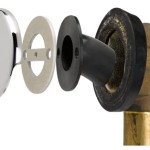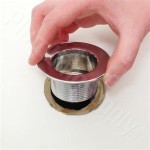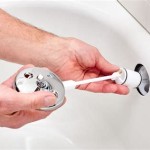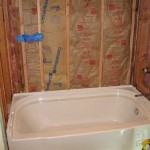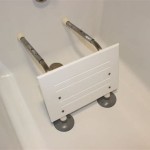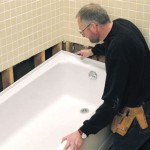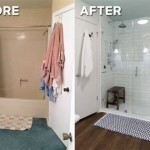Water Leaking From Ceiling: Tracing the Bathtub Connection
Discovering water leaking from a ceiling is a homeowner's nightmare, often signaling a complex underlying plumbing issue. When the leak appears directly below a bathroom, particularly near a bathtub, the likelihood of the bathtub being the source increases significantly. Pinpointing and addressing the cause promptly is crucial to prevent extensive water damage, mold growth, and costly repairs. This article explores the common causes of water leaks originating from bathtubs that manifest as ceiling leaks, the methods for diagnosing the problem, and steps to take to mitigate the damage.
Identifying Potential Bathtub Leak Sources
Several components associated with a bathtub can contribute to water leaks affecting the ceiling below. These potential sources range from visible areas such as the drain and overflow to concealed areas like the supply lines and the surrounding sealant. A systematic approach to identifying the source is essential for effective repair.
One of the most frequent culprits is a faulty or deteriorated bathtub drain. The drain assembly connects the bathtub to the drainpipe, typically made of metal or PVC. Over time, the seals and washers within the drain assembly can degrade, leading to leaks. Similarly, the flange connecting the drain to the tub itself can become loose or corroded, allowing water to seep through. The overflow drain, designed to prevent the tub from overflowing, is another common source. Like the main drain, the overflow drain uses seals and gaskets that can fail, resulting in leaks, especially when the tub is filled near its maximum capacity.
The water supply lines connected to the bathtub faucet are another potential source of leaks. These lines, usually made of copper, PEX, or flexible braided stainless steel, can develop pinhole leaks due to corrosion, age, or physical damage. The connections between the supply lines and the faucet, as well as the shut-off valves, are also vulnerable areas. Pressure fluctuations within the plumbing system can exacerbate existing weaknesses in these connections, causing them to leak intermittently or continuously.
Inadequate or damaged sealant around the bathtub is also a significant contributor to water leaks. Caulk or grout is used to seal the gap between the bathtub and the surrounding wall or floor. Over time, this sealant can crack, shrink, or peel away, creating openings for water to penetrate behind the tub and into the floor below. This is particularly problematic during showers or when the tub is filled, as water can easily seep through these gaps and down to the ceiling below.
Diagnostic Steps to Confirm the Bathtub as the Source
Once a ceiling leak is suspected to originate from a bathtub, a methodical diagnostic process is necessary to confirm the source and extent of the problem. This involves visual inspections, water tests, and careful observation of the leak's behavior in relation to bathtub usage.
The initial step is a thorough visual inspection of the bathtub area. This includes examining the sealant around the tub and the surrounding tiles or flooring for any cracks, gaps, or signs of water damage. The drain and overflow should also be inspected for visible leaks or corrosion. Any signs of water staining, mold growth, or peeling paint on the ceiling below the bathtub should be noted, as these can provide clues about the location and severity of the leak.
Next, perform a series of water tests to isolate the source of the leak. Start by plugging the bathtub drain and filling the tub partially with water. Observe the ceiling below for any signs of active leaking. If a leak appears, this suggests that the drain or tub body itself may be the source. Gradually increase the water level in the tub, paying close attention to the overflow drain. If the leak starts or intensifies when the water reaches the overflow, the overflow drain is likely the problem. After these tests, drain the tub and run the shower. Observe the ceiling below to see if this causes a leak, which would suggest that the caulking and sealant around the tub are compromised.
If the visual inspection and water tests do not clearly identify the source, a more detailed investigation may be required. This could involve removing access panels to inspect the plumbing and water supply lines directly. A moisture meter can be used to detect elevated moisture levels in the surrounding walls and floors, which can help pinpoint the location of the leak. In some cases, a borescope can be used to inspect hard-to-reach areas, such as inside wall cavities, without causing extensive damage.
Analyzing the patterns of the leak is also crucial. Note when the leak occurs and how long it lasts. Does it only happen when the shower is used, or does it occur even when the bathtub is not in use? Is the leak constant or intermittent? The answers to these questions can help narrow down the possible causes. For example, a leak that only occurs during showers suggests a problem with the sealant or showerhead connection, while a constant leak may indicate a problem with the supply lines.
Mitigating Damage and Implementing Repairs
Once the source of the water leak is identified, immediate action is needed to mitigate the damage and implement the necessary repairs. This involves addressing the immediate water intrusion and taking steps to prevent further damage to the structure.
The first step in mitigating the damage is to stop the leak as quickly as possible. This may involve shutting off the water supply to the bathtub, using a bucket to catch dripping water, and ventilating the affected area to promote drying. Remove any water-damaged materials, such as drywall or insulation, to prevent mold growth. If the leak is extensive, it may be necessary to call a professional water damage restoration company to remove excess water and dehumidify the area.
The specific repairs needed will depend on the source of the leak. For a leaky drain or overflow, the parts may need to be tightened or replaced. Replacing the entire drain assembly is a relatively straightforward task for a DIY enthusiast with basic plumbing skills. However, more complex repairs, such as replacing corroded pipes or damaged valves, may require the expertise of a licensed plumber.
If the leak is caused by inadequate sealant, the old sealant must be removed and replaced with new, high-quality caulk or grout. Ensure the area is clean and dry before applying the new sealant. Apply the sealant evenly and smoothly, paying particular attention to corners and joints. Allow the sealant to cure completely before exposing it to water.
In cases where the leak has caused significant damage to the ceiling below, the damaged drywall or plaster may need to be repaired or replaced. This involves cutting out the damaged section, installing new drywall or plaster, and finishing the surface to match the surrounding area. For extensive damage, it is advisable to consult a professional contractor to ensure the repairs are done correctly and safely.
Preventative measures are crucial to avoid future leaks. Regularly inspect the bathtub and surrounding areas for signs of damage, such as cracks, gaps, or water stains. Re-caulk or re-grout as needed to maintain a watertight seal. Avoid using abrasive cleaners that can damage the sealant. Periodically check the water supply lines and connections for leaks or corrosion. Consider installing a leak detection system that can alert you to potential problems before they cause significant damage.
Addressing water leaks promptly is essential to protect property and health. By understanding the common sources of bathtub leaks and implementing a systematic diagnostic and repair approach, homeowners can effectively resolve these issues and prevent further damage. When unsure, consult a qualified plumber for assistance, especially with complex repairs or when dealing with concealed plumbing.

Why Is Water Leaking From My Ceiling Ranshaw

Bath Leaking Through Ceiling Top Likely Causes

What To Do When The Bathtub Overflows And Leaks Downstairs

Water Leaking Through Ceiling Below Bathroom Easy Fix Diy Plumbing Fail

Water Stain On The Ceiling That S A Serious Plumbing Problem Reliance Sewer Drainage Inc

How To Address Water Damage On The Ceiling Under Bathroom

How To Check For Bathroom Leaks My Plumber Guide

Bathtub Leaking Through Ceiling How To Fix A Leaky

Shower Leaking Through Ceiling 8 Likely Causes

How To Tub Leak Detect Ceiling Under Bathroom Stop Leaking Easy
Related Posts

